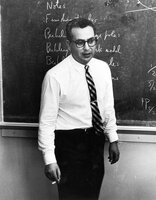Professor emeritus at the California Institute of Technology
Murray Gell-Mann, Caltech's Robert Andrews Millikan Professor of Theoretical Physics, Emeritus, and a winner of the 1969 Nobel Prize in Physics, passed away on May 24, 2019. He was 89 years old. Gell-Mann helped bring order to the field of particle physics in the 1950s and 1960s—a time when a bewildering array of new particles was being found in "atom-smashing" experiments. He devised a new method for sorting the particles into simple groups of eight, based on their electric charge, spin, and other characteristics (Israeli scientist Yuval Ne'eman also came up with a similar classification scheme). Gell-Mann termed his method the "eightfold way" after the Buddhist Eightfold Path to enlightenment, and for this research and related work he was awarded the Nobel Prize in Physics. He is perhaps best known for developing the theory of "quarks," indivisible components of matter that make up protons, neutrons, and various other subatomic particles. He famously named quarks after the exclamation, "Three quarks for Muster Mark!" in James Joyce's novel Finnegans Wake. Gell-Mann was born in New York City on September 15, 1929. His father, Arthur, was born in Austria and later moved to Manhattan to find work, securing a variety of jobs; he counseled children at an orphanage, worked on Wall Street, did German correspondence for a toy-importing firm, and opened a language school. In 1919, Arthur married Gell-Mann's mother Pauline, who was also born in Austria. He received his bachelor of science degree in physics from Yale University in 1948 and a doctorate in physics from MIT in 1951 From the 1950s through the 1970s, Gell-Mann played a leading role in helping to create the standard model of elementary physics. In 1951, he was a postdoctoral fellow at the Institute for Advanced Study and, from 1952 to 1953, he served as a visiting research professor at the University of Illinois at Urbana–Champaign. After serving as a visiting associate professor at Columbia University and then an associate professor at the University of Chicago from 1954 to 1955, he joined the Caltech faculty as an associate professor of physics. He came to Caltech with his first wife Margaret Dow, whom he had met at Princeton and married in 1955. Dow passed away in 1981. Gell-Mann became professor in 1956. In later years, Gell-Mann became interested in the issues of complexity at the heart of biology, ecology, sociology, and computer science. He co-founded the Santa Fe Institute in Santa Fe, New Mexico in 1984 to study such complex systems, and authored The Quark and the Jaguar, published in 1994, to present his ideas on simplicity and complexity to a general readership. He married his second wife, Marcia Southwick, in 1992 and retired from Caltech in 1993. Gell-Mann also served as University Professor at the University of New Mexico and the Presidential Professor of Physics and Medicine and Professor of Medicine and Physics and Astronomy at the University of Southern California. Gell-Mann was a member of the National Academy of Sciences and the Council on Foreign Relations; a foreign member of the Royal Society of London, the Pakistan Academy of Sciences, and the Indian Academy of Sciences; a fellow of the American Physical Society and the American Academy of Arts and Sciences; and an honorary member of the French Physical Society. Gell-Mann was a director of the John D. and Catherine T. MacArthur Foundation from 1979 to 2002 and was a board member of the Wildlife Conservation Society from 1994 to 2006. He served as chairman of the board of trustees of the Aspen Center for Physics from 1973 to 1979; was a Citizen Regent of the Smithsonian Institution from 1974 to 1988; and served on the U.S. President's Science Advisory Committee (1969–72) and on the President's Committee of Advisors on Science and Technology (1994–2001). He is survived by his children Nicholas Gell-Mann and Elizabeth Gell-Mann; and stepson Nicholas Southwick Levis.
